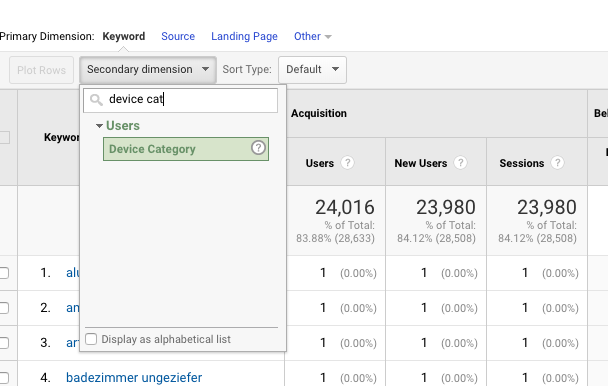Secondary Dimension in Google Analytics: Ideal Practices and Tips
Secondary Dimension in Google Analytics: Ideal Practices and Tips
Blog Article
Unlock Deeper Insights With Additional Dimension in Google Analytics
With the large area of data readily available in Google Analytics, the use of secondary measurements can dramatically enrich your logical abilities. These additional layers of information provide a nuanced perspective that can illuminate detailed details within your key metrics. By tactically integrating additional measurements right into your analysis, you can uncover beneficial understandings that could otherwise continue to be obscure. The capability to divide and translate customer habits with higher accuracy opens a realm of possibilities for enhancing techniques and boosting performance.
Recognizing Primary Vs. Additional Measurements
On the other hand, second measurements permit you to additional study your primary measurement information. By including a secondary dimension, you can layer on additional info to your primary dimension, allowing a more granular analysis. If your main measurement is the source/medium with which users arrived on your website, adding a secondary dimension like geographic place can reveal where those customers are situated geographically.
Using Secondary Measurements Properly
Properly using second dimensions in Google Analytics boosts the depth and granularity of data analysis, giving important insights right into user behavior and fads. By integrating second measurements alongside key measurements, online marketers and analysts can delve deeper right into the specifics of user interactions on their sites. Additional measurements allow individuals to section and filter main measurement information better, offering a more thorough view of user demographics, habits, and interactions. This can be specifically valuable when attempting to comprehend the impact of certain variables on user interaction, such as the tools or web browsers they are utilizing, the resources of their website traffic, or their geographic locations.
In addition, secondary dimensions allow individuals to contrast and contrast different information factors within a single record, facilitating a more comprehensive analysis of customer actions patterns. By leveraging additional measurements efficiently, organizations can discover hidden understandings, optimize their advertising and marketing techniques, and enhance the general user experience on their sites.
Discovering Common Additional Measurement Mixes
To better assess user habits and fads in Google Analytics, it is important to check out common mixes of secondary dimensions. Some usual second measurement mixes that provide beneficial understandings include evaluating website traffic resources with user locations to recognize where internet site visitors are coming from geographically and exactly how they located the website. Taking a look at user habits metrics with second measurements such as interests or demographics can assist in targeting details target market sections extra successfully.
Using Additional Measurement in Customized Information
Using second measurements in custom reports enables a much more extensive evaluation of information in Google Analytics, improving the deepness of understandings gotten. When creating customized records in Google Analytics, including additional dimensions can provide a much more comprehensive view of exactly how different dimensions interact with each various other. This function enables individuals to dig deeper into their data and discover beneficial relationships that might not be instantly obvious.
By applying second measurements in custom reports, users can acquire a far better understanding of their internet site or app web traffic. Incorporating the primary dimension of "source/medium" with the second dimension of "touchdown web page" can expose which touchdown web pages are executing ideal for website traffic coming from particular sources. This insight can help marketers enhance their campaigns and enhance total conversion prices.

Enhancing Information Visualization With Secondary Measurement
When checking out data in Google Analytics personalized reports, incorporating secondary dimensions not just offers an extra comprehensive evaluation but likewise boosts the graph of understandings with information visualization. By including a secondary measurement to your reports, you can enhance the method information exists, making it easier to identify patterns, patterns, and connections within your site's efficiency metrics.
Second measurements can aid you section your information further, enabling a deeper understanding of customer behavior and communications on your website. When trying to isolate certain variables that may affect your internet site's efficiency., this boosted degree of granularity can be especially beneficial.

Final Thought
To conclude, leveraging second measurements in Google Analytics permits a more detailed evaluation of data, leading to much deeper understandings and more educated decision-making. Secondary Dimension in Google Analytics. By adding additional layers of details to main information collections, marketing professionals and analysts can reveal surprise patterns, patterns, and correlations that provide a granular sight of customer actions and communications. This improved degree of insight makes it possible for optimization of campaigns and tailored strategies for certain audience segments, ultimately enhancing performance and conversion rates
On the various other hand, secondary dimensions permit you to further explore your primary dimension data. By adding an additional measurement, you can layer on additional details to your primary dimension, allowing an extra granular analysis. If your main measurement is the source/medium via which users got here on your website, adding a second measurement like geographical area can disclose where those customers are located geographically. By incorporating secondary measurements along with key dimensions, experts and marketers can dive much deeper right into the specifics of customer interactions on their sites. Second measurements enable you can try these out users to check sector and filter key measurement information even more, using a much more comprehensive sight of customer communications, habits, and demographics.
Report this page